TRADES LANDSCAPE

















10 SLICK CONDITIONS
How building and maintaining winter and ice roads provides a lifeline for northern communities.

 BY KARINA SINCLAIR
BY KARINA SINCLAIR
16 CLEARING SNOW COAST TO COAST
Climate change continues to present fresh challenges for winter maintenance — here’s how municipalities and contractors are getting ready for the season.
 BY KARINA SINCLAIR
BY KARINA SINCLAIR
Connecting remote northern communities along
Road.
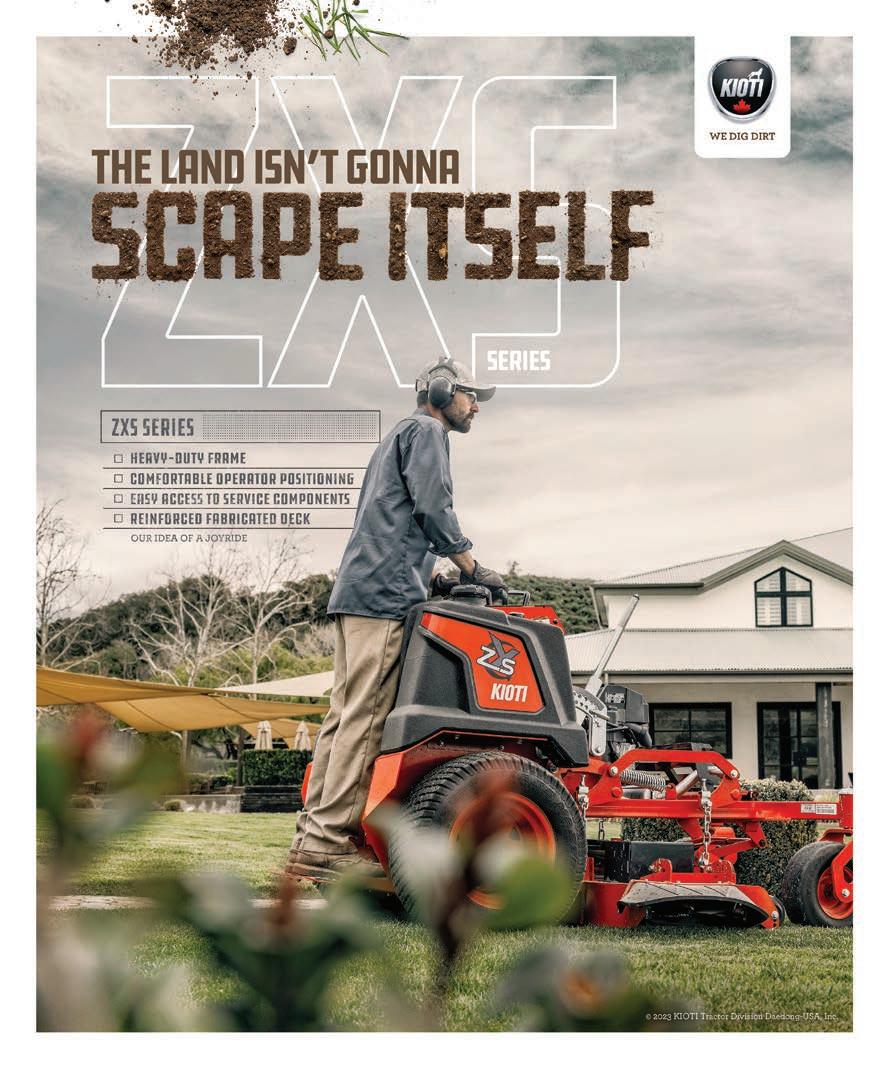
COMMUNICATIONS DIRECTOR

Kali Pearson
CREATIVE DIRECTOR
Mike Wasilewski
ASSISTANT EDITOR
Robert Ellidge
MULTIMEDIA JOURNALIST
Karina Sinclair
ACCOUNT MANAGER
Greg Sumsion
ACCOUNT MANAGER
Liz Lant
COMMUNICATIONS COORDINATOR
Angela Lindsay
DIGITAL MARKETING SPECIALIST
Charlotte Guena
ACCOUNTANT
Joe Sabatino
STAFF CONTACT INFO AT LANDSCAPETRADES.COM/CONTACT
ADVISORY COMMITTEE
Gerald Boot CLM, Lindsay Drake Nightingale, Jeremy Feenstra, Mark Fisher, Hank Gelderman CHT, Bob Tubby CLM, Nick Winkelmolen
Landscape Trades is published by Landscape Ontario Horticultural Trades Association 7856 Fifth Line South, Milton, ON L9T 2X8 comments@landscapetrades.com www.landscapetrades.com
Landscape Trades is published six times a year: February, March, May, August, October and December.
SUBSCRIPTION RATES:
One year – $46.90 | Two years – $84.74 | Three years – $118.64 HST included. U.S. and international please add $20.00 per year for postage and handling.
Subscribe at www.landscapetrades.com
Copyright 2023. All rights are reserved. Material may not be reproduced in any form without written permission from the publisher. Landscape Trades assumes no responsibility for, and does not endorse the contents of, any advertisements

8
BY JON AGG BY BALDO & SANTO GUCCIARDIHow
BY DR. NADINA GALLE BY ROB KENNALEY





 BY JON AGG
BY JON AGG
THE SNOW AND ICE management industry is facing an insurance and liability crisis — and it’s essential we act now. The availability, scope and price of insurance is unstable and many contractors are being driven out of the industry. Without meaningful change from the Ontario government, the problem will only fester and get worse.
There is a very real danger that the declining number of snow and ice contractors will result in a lack of service for many municipalities and organizations next winter, unless there is legislated reform. And while the Ontario government passed the Occupiers’ Liability Amendment Act (Bill 118) in 2020 in an attempt to alleviate the effects of frivolous slip and fall claims, this legislation is not enough on its own to solve the numerous problems our industry is facing.
Ultimately, we believe that winter safety should be a shared responsibility for all involved, including contractors, property owners, property managers, the public, municipalities and other levels of government. However, snow and ice contractors are currently shouldering the bulk of liability risk — and that means many are going out of business due to skyrocketing liability insurance rates, on top of other rising costs such as fuel, materials, labour and auto insurance.
Landscape Ontario’s Snow and Ice Management Sector Group has retained the public and government relations firm Daisy Group to help achieve our critical objectives for legislative change. These include the establishment of technical standards and a regulatory body with the overall goal of creating a fair and effective system, ensuring all have access to snow removal services.
With that in mind, I am excited to share news of the great progress we have been making over the past few months.
Most notably, we had a very successful meeting with Premier Ford’s Chief of Staff, who is interested in both our concerns and the solutions we bring to the table. Our meetings with the ministries of Transportation and Environment have also been very positive. I feel that the
Ontario Government recognizes the importance of our industry and the services we provide — and are willing to work with us to find a solution that will be fair to all.
We will keep the momentum going with upcoming meetings with several other ministries including the Ministry of Labour, Immigration, Training and Skills Development and the Ministry of Economic Development, Job Creation and Trade. We will also continue having additional conversations with the Premier’s office.
To help further our advocacy and better connect with decision-makers, the Sector Group will also be hosting a Lobby Day at Queen’s Park sponsored by the Honourable Parm Gill, Milton MPP and Minister of Red Tape Reduction on October 24. This event is an incredible opportunity to showcase our industry, the issues we are facing, and meet with Ministers, MPPs and other stakeholders.
If you are interested in meeting with your local MPP, either at Queen’s Park or at a local office, please let us know. We can assist with setting up the meetings and provide a briefing note for these important issues.
I feel very encouraged by the progress we have been making. There is still a long road ahead, but we can achieve our goals if we continue to work together.
Your input is important, so please reach out to the Landscape Ontario Snow and Ice Management Sector Group (you can email kbylsma@landscapeontario.com) to share your experience with liability, rising cost of business or positive stories from customers — it all helps! In the meantime, stay tuned for more updates and ways you can contribute to this critical effort which benefits all snow and ice management contractors throughout the province. Support, through a financial contribution, is also urgently needed to support our efforts. If you are able to contribute, you can send it via e-transfer to etransfer@landscapeontario. com to support this ongoing effort. Please include the word “snow” in the message. We thank you in advance for your support for this important cause. Thank You!. LT
LIMELIGHT PRIME ®
Hydrangea
Long Blooming | Strong Stems | Vibrant Color


Limelight Prime ® panicle hydrangea is an improved, more refined ‘Limelight’ with darker foliage, stronger stems, and a more upright, compact habit. Lime green blooms maintain their color longer until transitioning to a rich pink. Landscapes will love Limelight Prime ® hydrangea.

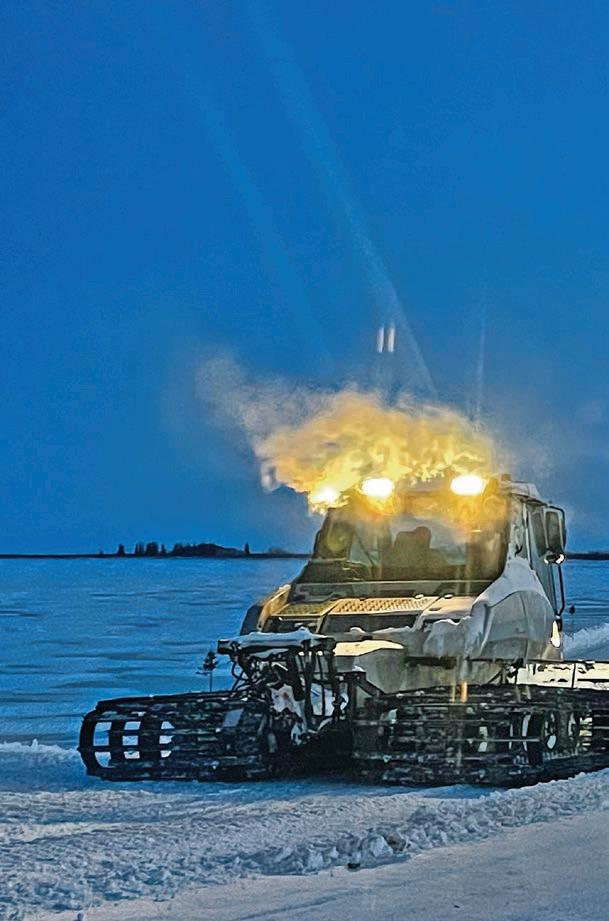


When tasked with plowing roadways in most of Canada, minimizing ice is a basic expectation for snow and ice management professionals. But what if an icy road is the goal? Temporary winter roads and ice roads are lifelines for northern communities. Of course, building and maintaining them is a completely different matter compared to all-season roads those of us in temperate locales are used to.
A winter road is a temporary transportation route that runs over fr ozen land and water. The winter road could also pass over peatlands or muskeg swamp terrain and these land-based portions are known as portage. An ice road is built on floating frozen stretches of lakes, rivers, and parts of the sea, and incorporates ice bridges to connect to the shoreline. In all cases, the ice must be thick enough to support the weight of vehicles and cargo, which requires the expertise of engineers, patrollers, flooders, and snow plow and grader operators.




According to the Department of Northern Development, Ontario has the longest winter road network in Canada, stretching 3,200 kilometres. Approximately 24,000 northern Ontarians rely on these ice roads, which are only open for six to 11 weeks a year — from January to the end of March.
Part of that network is the 312-km James Bay Winter Road, which connects three remote Indigenous communities and the Town of Moosonee. This passage is essential for transporting goods to the Indigenous First Nations of Attawapiskat, Fort Albany, and Kashechewan that are otherwise inaccessible the rest of the year (unless a $1,250 round trip plane ticket is in the budget).
Nancy Wood is the president and project manager of Kimesskanemenow LP, the company responsible for all work done on the James Bay Winter Road. The word kimesskanemenow is a Cree word which means “this is our road.” Not only does the winter road connect the remote First Nations communities, it provides seasonal employment. Wood says the purpose is to ensure there is sufficient ice to safely deliver all necessary equipment to the communities, including fuel and construction supplies to build schools, homes, medical centres and stores.
Although it’s not the only winter road in Ontario, the James Bay route does have a particular challenge. “We cross over approximately 58 water crossings, five of which are major tidal rivers,” Wood said. “One of those crossings over the Albany River is 1.6 km and the other is 900 metres. So they’re both pretty large and there is no bridge. It’s just an ice bridge. Since this is a tidal river, they go up and down every day so it’s challenging to make sure the ramps stay suitable.”
Some years, the weather cooperates and makes construction and maintenance of ice roads easier. “The 2021/22 winter road season was amazing,” Wood said. “It was really, really cold in December, and so the muskeg froze really solid. We didn’t get any snow, which acts as an insulator and sometimes prevents it from freezing solid. It was great. We got everything we wanted in that season. We got everything we wanted out. It was fabulous.”
A warmer winter might have Canadians in urban centres cheering, but not so in the remote north. “Last winter [2022/23], it was very warm during the initial construction in December and we got a lot of snow,” Wood
lamented. “We had real challenges trying to drive the frost into the muskeg to get it solid enough to have all these big heavy trucks traveling on them.”
So how does such a road even get built? Nature takes the first step. Ice begins to form on northern lakes and rivers in autumn and is considered safe enough to walk on when it is at least 10 cm thick. By 18 cm, the ice can bear snowmobiles and riders. Amphibious tracked vehicles can begin to clear snow from the route at 30 cm. And so long as the ice is generally free from cracks and reaches a minimum thickness of 40 cm, large grooming machines can now complete the process, and plow the route to its full 45 m width. That is roughly the width of a 12-lane permanent highway.
Removing snow from the ice surface helps create thicker ice. This is because of the insulating properties of snow. As snow is pushed to the edges to create snowbanks, the thicker ice in the cleared driving lanes becomes more buoyant than the thinner ice under the snowbanks. This could lead to cracks and bends in the lanes, which have to be monitored and repaired if they extend all the way through the ice.
Local contractors from the served communities are the ones who manage the construction and maintenance. “They’ve been doing it for a long time. These guys that are running these pieces of equipment are amazing,” Wood said. “Just to watch them with the loaders, graders and water trucks is quite fascinating because they really know what they’re doing. They know which areas are going to be problematic and how to deal with it. Every area has their own little tricks.”
The extreme weather conditions and dangerous elements makes it difficult to find workers to fill all the roles. Many of the experienced equipment operators are getting older and Wood said the available workforce is in transition. “Some operators are reluctant to let somebody who has just gotten their heavy equipment operator training to run their $300,000 piece of equipment. So it will continue to be a challenge because a lot of the gentlemen that have been working for years and years are either retiring or have passed away.”
While these are well paid jobs, they are daunting. If a stretch of ice is still too thin, a worker needs to drill holes in the ice, pump

water up from below and flood the surface. “I don’t know that I would be really interested in standing outside doing flooding when it’s 35 below for six weeks at a time,” Wood said, adding that in the past year, the crossings needed to be 60 inches (152 cm) thick in order to carry out the heavy equipment from the former De Beers Victor Mine. “That’s a lot of flooding. The natural ice might be 30 inches (76 cm), so we’re flooding that ice to be almost as tall as I am.”
In the throes of snow clearing, permanent roads get scattered with grit, salt, and other liquids meant to prevent ice from accumulating on asphalt. A winter road that spans frozen water and swampland requires a different approach. “We don’t use sand or salt,” Woods said. “If you think about muskeg, it’s very dark, almost black. Once the sun hits the black, it absorbs the heat and it melts really quickly. So a lot of what we’re trying to do once the road is open is cover up the dark spots with snow so the road doesn’t melt prematurely.”
To add to the winter road’s durability, some of the crews use retrofitted milk tankers that spray water to add an ice cap about four centimetres thick. “And then, to make it less slippery, especially on sharp corners, we scarify it. We’ve got these graders and loaders with the teeth that basically are dragging grooves in the road.” Wood also said drivers can gain a little traction by driving along the edge of the road near the snowbank which is generally snow
covered, and not as slippery as the middle of the lane. “But every year we have people that take the corners too fast and have to be pulled out of the snowbank.” Incidentally, accidents involving vehicles hitting each other are very rare on ice roads.
The road usually opens to light truck traffic near the end of January, and if the weather conditions stay favourable, remains open until early April. Travellers are advised to check for updates on the road’s website, as weather and temperatures fluctuate. For example, in March 2023, the James Bay Winter Road briefly closed to hauling, citing warm weather had degraded the road and could not be repaired until it got cold enough again. The road finally closed to heavy traffic for the season March 31, and to light traffic April 2.
For the past several seasons, Wood has relocated to Moosonee during the winter road season to manage the James Bay Winter Road project on-site. She said it’s astonishing when it gets dark at 4:30 p.m. “This is a really, really, long, long, long, long night,” Wood said. “I know many of the community members prefer to drive at night because you can see the humps in the road better and you’re not snow blind. Driving on an ice road, as you can imagine, isn’t the same. You slam your brakes on, you’re going to have a problem. You have to learn how to slow down without pumping your brakes. It’s
just a more defensive way of driving.”
Drivers on the winter road system should not expect to cruise along straightaways at 100 km and stop for fuel at regularly spaced service stations (plywood outhouses might crop up every four or five hours). Speeds are always dictated by ice depth, water depth beneath the ice, and weight of the vehicle.

The suggested maximum speed limit for a fully loaded transport truck is 50 km/h, and that depends on ice meeting the minimum required depth for its weight. This is to help avoid deflection bowls that move along with the vehicle, creating waves in the water underneath the ice. Going faster than recommended increases ice stresses, cracking, blowouts, and breakthroughs. When meeting oncoming traffic, passing flood crews, and approaching shore lines, speed limits drop to 30 km/h.
At the end of the season, parts of the road get dismantled. “Every year once the road is closed we drill the ice in the Albany River in hopes that by putting holes in it, it will encourage it to break up so we don’t have 40foot, two-kilometre-wide pieces of ice going down the river and causing flooding,” Woods said. This is a key step for communities like Fort Albany and Kashechewan, which are very close to sea level.
Any professional working on the ice roads needs to follow rigorous safety protocols. The Best Practices for Building and Working Safely on Ice Covers in Ontario is published by the Infrastructure Health and Safety Association. According to this manual, wheeled vehicles should be equipped with a winch, and all vehicles must have two-way radios or satellite phones, as well as survival supplies (such as ice rescue picks, buoyant rescue rope, and warm clothing).
There is always a possibility of ice cracks and breakthroughs, adding the risk of drowning and/ or hypothermia — something not usually expected for plow drivers on traditional, permanent roads. High-visibility survival flotation suits and other flotation devices must be worn, especially when the ice thickness or quality is unknown. Knowing how to self-rescue during a cold water immersion could save a worker’s life.
Just one more dramatic example of how snow and ice management differs in the Great White North. LT
ADVANTAGE FARM EQUIPMENT
Wyoming 1-866-713-6656
BOBCAT OF BARRIE
Barrie 705-726-2228
www.OakenEquipment.ca
BOBCAT OF BRANTFORD, INC.
Brantford 519-752-7900
www.BobcatofBrantford.com
BOBCAT OF DURHAM EAST, LTD.
Courtice 905-404-9990
www.BobcatofDurhamEast.com
BOBCAT OF GREY BRUCE
Owen Sound 519-372-9100
www.BobcatofTC.com
BOBCAT OF HAMILTON, LTD.
Stoney Creek 905-643-3177
www.BobcatofHamilton.com
BOBCAT OF HURON
Walton 877-887-6365
BOBCAT OF LONDON, LTD.
London 519-455-4900
www.BobcatofLondon.ca
BOBCAT OF MUSKOKA
Muskoka 249-390-7000
www.OakenEquipment.ca
BOBCAT OF PARRY SOUND
Nobel 705-342-1717

www.BobcatofParrySound.com
BOBCAT OF PETERBOROUGH
Peterborough 705-748-9199
www.BobcatofPeterborough.com
BOBCAT OF SAULT STE. MARIE
Sault Ste. Marie 705-949-7379
www.Bobcat-ssm.com
BOBCAT OF STRATFORD
Stratford 519-393-6040
www.BobcatofStratford.ca
BOBCAT OF THE TRI-CITIES, LTD.
Kitchener 519-579-9100
www.BobcatofTC.com
BOBCAT OF WINDSOR
Windsor 844-807-0120
www.OakenEquipment.ca
BOBCAT OF TORONTO
Brampton 416-679-4172
Scarborough 416-679-4171
www.OakenEquipment.ca
Equipment World Inc.

Thunder bay 807-623-9561
www.Bobcat-tbay.com
KUCERA GROUP CHATHAM
Chatham 519-351-4300
JOHN'S EQUIPMENT
SALES & SERVICE, LTD.
Frankford 613-398-6522
www.JohnsEquipmentSales.com
If you have the will to take on more acres of hard work, Bobcat has the way.


In midsummer, it feels difficult to focus on anything other than maintaining gardens, installing pools and building decks. Thanks to a voracious wildfire season and record-breaking temperatures across many provinces, the concept of winter is almost inconceivable; snow, freezing rain, and dramatic drops in mercury seem far, far away. Unless, of course, you’re a snow and ice management professional. Planning for winter road maintenance is already underway in municipalities from coast to coast. Operations managers, public works crews, and private subcontractors are working together to improve road clearing best practices for public safety. Landscape Trades reached out to municipalities and private snow contractors across the country to learn more about the evolving challenges presented by a changing climate and winter weather.
To clarify, ‘weather’ and ‘climate” are not interchangeable terms. According to NASA, “weather is what conditions of the atmosphere are over a short period of time, and climate is how the atmosphere behaves over relatively long periods of time. When we talk about climate change, we talk about changes in long-term averages of daily weather.” These longlasting shifts in weather patterns can have profound impacts on the environment, resources, and every living thing on the planet. It also means what worked in the past might not in the future.

Because of its northerly location, Canada experiences climate change at twice the average global rate, according to Natural Resources Canada. Across much of Canada, snow cover has decreased between five and 10 per cent since 1981, and according to Canada’s Changing Climate Report, it is likely that snow cover duration will decline due to warmer surface air temperature caused by emissions. Research from Environment Canada and Climate Change shows the seasonal average temperature for winter increased 3.3 C between 1948 and 2022. Populations in shifting climate zones are experiencing changes in typical weather conditions, such as the timing of freeze-thaw cycles or precipitation types, which means new challenges for snow and ice professionals.
Vancouver, B.C., with its proximity to the Pacific Ocean, has historically experienced mild winters with little snow. “This year was a very large year for us; we were over 80 centimeters of snow, which is a lot for Vancouver,” said Amy Sidwell, manager of street operations in Vancouver, “I would say we definitely are seeing more extreme weather events overall in the
city of Vancouver and are monitoring these trends to see what we need to do to change our services.” Sidwell said they have a large municipal workforce that can pivot from other tasks to help clear roads during extreme snow events.

The maritime climate of New Brunswick means milder winters than continental climates, but the area does experience more cyclonic storms, such as Nor’easters. Don Morehouse, director of public works for the city of Moncton, N.B., says he’s noticed snow is starting later in the season. “When it does come, it comes over a very short period of time very quickly,” Morehouse said. “In a month, we can have four or five [storm] events come across in series.” This creates a challenge to find space to store large amounts of snow, instead of dealing with smaller amounts throughout the season. Morehouse also noted that some storms, especially near the start or tail-end of the season, seem to linger a whole day while bringing a messy mix of precipitation that also results in black ice.
The island city of Montreal, Que., is classified as having a humid continental climate and is notorious for cold, snowy
winters — something residents seem rather proud of. “I’m convinced that we’re the best city when it comes to trying to remove the snow,” city spokesperson Philippe Sabourin said. “We’re dealing, all in all, with 190 centimeters of snow every season. We remove 12 million cubic meters of snow every winter. The big challenge for the city is rain during the winter, especially when we get warmer temperatures and we have a big swing heading back to the cold temperature. Then the rain turns to ice. That’s always a challenge.”
Rocco Spalvieri, grounds maintenance manager at International Landscaping Inc. in Milton, Ont., said warmer temperatures complicate storm predictability. “Each storm event now will include several types of precipitation. A storm may start as rain, change to freezing rain, back to rain, then wet thunder snow and finally finish with high winds and freezing temperatures,” said Spalvieri. This makes it challenging to coordinate response teams. “Timing when sidewalk crews, snow plowing and de-icing equipment is dispatched is critical to an effective snow plan.”

Conquer Canadian winter with Kubota’s powerful RTV commercial attachment lineup. Clear snow, tackle tough jobs, and maximize productivity. Blades, snowblower, sweeper, salt spreaders – we’ve got you covered. Harness the power, comfort, and reliability.
Kubota: your winter work companion.





The wild swing between snow to rain to freezing rain frustrates road crews who want to reduce salt usage. “Temperatures bouncing around the freezing point are creating risky, icy conditions more regularly. In short term situations, the salt is a total waste,” said Mitchell. “Risk of ice or freezing rain is the dangerous stuff that legitimately creates slip-and-fall conditions that we try so hard to avoid.” He laments that so much salt gets applied for freezing conditions only for rain to wash efforts down the drain.
To reduce their salt usage to half the industry average per square foot, MPM added geofenced GPS salt-tracking devices to improve on current salt metering, tracking, ground speed and rate-adjusting devices. “We also added monitored weather stations with air and surface level temperature sensors,” Mitchell said, stating this will help inform event timing and necessary de-icing applications.
On Montreal’s 11,000 km of steep streets, bridges, sidewalks and bike paths, Sabourin says the city uses nearly 200,000 tonnes of rock and salt to prevent slippery conditions. “We tried everything to replace the salt but we couldn’t find any solution that could be as efficient,” Sabourin said, referring to their dissatisfactory experience with materials such as coffee grounds and red beet juice brine. “We are spreading less salt, but we’re going on the road more often, making sure the salt will act promptly and correctly. So we already made a lot of changes in the way we’re doing the operation. Adjustments will have to be made, but I’m pretty confident that we’re one step ahead of climate change.”
The City of Vancouver doesn’t use beet juice in their brine treatment either, but Milton, Ont.-based International Landscaping Inc. has had great success with beet juice additives and they encourage their clients to adopt environmentally sustainable products. “However, these products and equipment are typically more expensive and not all clients are in a budgetary position to afford their use,” Spalvieri said. “We therefore sometimes end up using these more expensive and sustainable products on client properties and are not always reimbursed for their usage. All our salt is treated with EcoSolutions Fusion with no exceptions.”

Forecasting is key, but each municipality has a unique approach tailored to their local geography and residents’ expectations. The Vancouver operations team relies on their forecasting agency, which sends forecast updates four times a day during the winter. “Some of those forecasts will be as far out as a week in advance,” Sidwell said. “If we see that there’s going to be no rain for the next few days and snow is coming, then we’ll start doing brine or salting work a couple of days in advance just to make sure we can cover the whole city and get all that work done before the snow starts to fall.”
Montreal spokesperson Sabourin says they follow the forecast to deploy anti-icing crews as close to the weather event as possible. “Generally speaking, we’re spreading a few minutes before the rain or snow — just a few minutes before, not an hour before,” Sabourin said. “Otherwise the trucks and cars would remove the little rocks or the salt.”
In the Kitchener-Waterloo region of Ontario, James Mitchell, owner and operator of Mitchell Property Maintenance (MPM), cautions that a stormy forecast can prompt over-reaction. “We had a record number of freezing rain events in 2022/23 by early February — more than the past two seasons combined,” Mitchell said. “We’ve also had risk of weather causing action by contractors that was not required by the resulting weather, but fully justifiable by the forecast. If the weatherman is only right half of the time, that is about the same accuracy as the service actions provided by snow contractors.”
While Moncton uses meteorological forecasts for planning as well, the public works department and their sub-contractors also observe social media to gain a better sense of current conditions. “We are more in tune with the motorists,” Morehouse said. “They have a lot more ways to tell us when conditions are getting poor. It’s also a way to capture feedback on how well our service is working.”
In addition to spreading salt and de-icer, snow clearing professionals are also adopting new equipment and technologies to improve their services. Montreal uses GPS to allow residents to track road clearing progress with their INFO-Neige mobile app, but also to collect data to better understand how efficiently they are adapting to climate change. “We’re always looking for new technologies and equipment that could be used by the city,” said Sabourin, and pointed out how the city has attached bigger trailers to the small trucks used on sidewalks so they can treat longer stretches of sidewalks with salt.
In Vancouver, they use ride-on units for clearing pedestrian paths, giving priority to bridges, sidewalks and 16 of their mostused bike routes. “We’ve also installed some remote weather information stations (RWIS), so those will give us road and air temperature information that helps us understand conditions throughout the city,” said Sidwell.
Like other cities, Moncton monitors conditions with RWIS and weather stations from Davis Instruments: “That gives us humidity, tracks freezing points, and shows what’s happening right now,” Morehouse said. They also use DICKEY-johns on their fleet to set salt application rates and every vehicle is equipped with road



temperature sensors. This helps operators anticipate localized areas of black ice as they travel. The city is also looking at different kinds of plow blades that adjust to the roads’ surface so they can use more mechanical means of clearing snow as opposed to chemicals.
Ultimately, Morehouse says Moncton finds communication is one of their best tools for coping with major winter events. “We use social media to warn people to slow down, give yourself more time, don’t go out if you don’t have to,” Morehouse said, explaining that they’re very proactive about providing information to residents to set expectations. “When people are aware of some of the challenges that the operations are facing, then they understand. If you don’t communicate to your customer how you’re providing a service, I think you’re quickly going to affect the confidence they have in you.”
The changing climate will force communities to adapt, possibly at a faster rate than previously thought. With wild swings in temperature, messy precipitation mixes, and a growing concern about the impact of salt on the environment, road operations in the future might look very different.


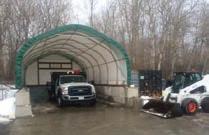

Montreal now incorporates climate change with their conception of the street. “When we’re building a new
street or doing construction, we take into consideration that we’re going to have to deal with more episodes of heavy rain during the summer and winter as well. So when we’re rebuilding the streets in Montreal, we’re building a bigger sewer, too, to be able to manage all of the rainwater. We’re also adding some bioretention basins that help redirect the rain into vegetation.” These basins, along with “water squares” incorporated into public spaces, help reduce flooding from blocked drains. Instead of overloading the sewers, the excess water benefits green spaces.
In Moncton, Morehouse thinks more focus on active transportation will reduce the pressure of clearing roads for private vehicles. This could mean facilitating pedestrian movement by creating more all-season bike lanes or creating accessible infrastructure that promotes the use of mass public transit. “I think we just have to always be adapting and be open to what works best for our city. We need to calibrate and track data and use that to make decisions based upon a trend versus a one-off,” Morehouse said. “You can’t work in a silo. Road authorities can’t work separately from planning. They can’t work separately from development. They can’t work separately from communication. We’ve got to work as a unit and you have to always have that plan B.” LT

ONE OF THE MOST important keys to successfully managing winter maintenance operations is to have the latest and most reliable weather forecasting system(s) at your disposal. But as anyone who has ever tried to plan for the weather knows, even the best tools can’t always get it right.
The earth’s atmosphere is a highly complex system with intricate interactions between air, water and energy. Small changes in any one part of the system can have far-reaching effects, making it challenging to accurately model weather patterns. Limits to observational data due to gaps in observing humidity, wind speed and atmospheric pressure over remote or oceanic regions can also limit the accuracy of predictions.
Weather forecasting involves mathematical models that simulate the behavior of the atmosphere, but weather systems can be uncertain and even chaotic. And while mathematical models have improved over time, they still face challenges in accurately representing all aspects of the atmosphere. Even small uncertainties can lead to significant divergence in the predicted outcomes, making long-range forecasts more challenging.
Despite all these challenges, advancements in technology, improved observational capabilities and ongoing research efforts continue to enhance weather prediction accuracy.
Since we haven’t quite perfected predicting the weather, careful planning, preparation and efficient execution is key. Here are some key strategies to keep in mind:
• Develop a winter operations plan: Your plan should outline the objectives, strategies and resources required for winter management in your area. This plan should also include protocols for snow and ice removal, equipment maintenance, staff assignments and communication procedures.
• Ensure adequate equipment and resources: Make sure you have the necessary equipment and resources for effective winter management. Your equipment should be regularly maintained and inspected to ensure proper functioning all winter long.
• Use monitoring and forecasting: Collaborate with local meteorological agencies or subscribe to weather alert services for accurate and timely information. This helps you anticipate the types of conditions you will be working with.
• Prioritize safety: Safety should be the top priority during winter operations. Develop safety protocols for your staff, such as proper use of equipment, wearing appropriate personal protective equipment (PPE) and creating guidelines for pedestrian safety and safe driving.
• Implement efficient snow and ice removal strategies: Prioritize cleaning major roadways, intersections and high traffic areas first, followed by secondary roads and parking lots. Use appropriate de-icing materials to minimize ice formation and enhance traction. Clear walkways and entrances to ensure safe passage for pedestrians.
• Prioritize communication and coordination: Establish clear communication channels to keep staff, stakeholders and the public informed during winter operations. Maintain regular communication with your team, providing updates on weather conditions, operational plans and any changes in schedules. Use digital platforms, email or text messages to disseminate important information to employees, tenants or customers.






• Commit to continuous improvement and evaluation: After each winter event, evaluate your operations and identify areas for improvement. Assess the effectiveness of your strategies, equipment performance, staff training and response time. Learn from past experiences to refine your winter management plan for future events.
Remember, effective winter management requires flexibility and adaptability to changing conditions. Regularly review and update your

strategies based on feedback, technological advancements and industry best practices to ensure efficient operations and maximize safety during winter weather events. LT
Baldo & Santo Gucciardi are the founders of International Landscaping Inc. and EcoSolutions, located in Milton, Ont. ILI offers a full range of landscaping services, including winter maintenance, and actively seeks environmentally responsible methods to reduce salt use.



Advancements in data collection, technology and computational capabilities have evolved significantly over time — from the earliest known observations of the sky dating back thousands of years and the invention of the barometer, to machine learning applications of today.

Weather observations date back thousands of years, with ancient civilizations noting patterns in the sky and weather conditions. Early tools, including the barometer and thermometer, allowed for more quantitative measurements in the seventeenth and eighteenth centuries.
In the mid-nineteenth century, the invention of the telegraph enabled the rapid transmission of weather observations over long distances. This gave rise to national weather services which provided centralized forecasting and warnings.
Numerical Weather Predictions (NWP) were developed in the midtwentieth century and revolutionized weather forecasting. NWP involves using mathematical models to simulate the atmosphere’s behaviour based on initial conditions and physical laws. The rise of computers played a crucial role in solving the complex equations, allowing for more accurate and detailed predictions.
The launch of weather satellites

in the late 1950s and early 1960s provided a global view of Earth’s atmosphere. Satellite data, including cloud patterns, temperature and moisture distribution significantly enhanced the understanding of weather systems and improved prediction accuracy. Also in the 1960s, the Doppler radar was introduced — enabling detailed observations of precipitation and wind patterns. This technology improved the detection and tracking of severe weather phenomena.
In the late twentieth century, data assimilation integrated diverse observational data into numerical models. This process helped reduce errors in initial conditions, improving the accuracy of forecasts.
Ensemble forecasting, which involved running multiple simulations with slightly varied initial conditions to capture uncertainties in predictions, was introduced in the 1990s.
In the years since, advances in computing power have enabled the development of high-resolution models that simulate atmospheric processes with more detail.
Most recently, machine learning techniques have been integrated into weather prediction processes. These methods allow for the analysis of large data sets, pattern recognition and the development of more accurate models.



 BY DR. NADINA GALLE
BY DR. NADINA GALLE
WHEN YOU VISIT YOUR DOCTOR, they ask questions to help paint a picture of your overall health. However, this approach fails to account for the impact of one crucial factor: your postal code.
Studies have shown that where you live can significantly affect your health and life expectancy. For example, a Danish Twin Study revealed that contrary to popular belief, genetics only account for approximately 20 per cent of our longevity. The remaining 80 per cent is determined by various environmental, behavioural, social, and economic factors commonly called “environmental and social determinants of health.” These factors, which include access to education, quality housing, safe neighbourhoods and healthy food options, can greatly impact
one’s health outcomes and overall quality of life. It also indicates living closer to nature plays a major role. In fact, study after study indicates that exposure to nature profoundly affects our physical, mental and emotional well-being.
To enhance nature exposure at home and in our communities, accurate measurement is essential. However, effective tools are scarce for quantifying nature, evaluating exposure, tracking progress, and incorporating new data sources. As a result, analyzing these aspects is cumbersome and time-consuming. There is also a lack of agreement on a universally accepted method for measuring or assessing nature exposure.
In 2021, I had the privilege to meet the founders of NatureQuant. This Eugene, Oregon-based startup combines data and remote-sensing technologies to create nature “heat maps” that show how healthy a specific location will likely be based on its natural elements.
NatureQuant utilizes diverse inputs to capture a comprehensive view of the environment. These inputs span from the immediate vicinity of a home to a onekilometre radius of the subject location. By
combining different data sources such as land cover types, vegetation densities and built city elements, NatureQuant can gather a wealth of information. This data is collected from various sources, including aerial photography, satellite-based vegetation measurement, GIS databases and object-based imagery analysis tools. Furthermore, NatureQuant also considers factors such as air quality, noise pollution, urban heat islands and light pollution. With this holistic approach, NatureQuant creates NatureScore™ — a numerical
rating system that uses machine learning to determine the health benefits of nature exposure in a specific location. This rating is represented by a score between 0-100 and categorized into one-to-five colour-coded “leafs” to make it easy to understand.
Nature access may be one of the most critical determinants of health, making the creation and cultivation of private and public green spaces critical. Whether it’s a hike in the
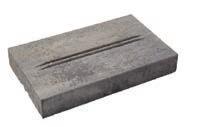
The Nueva® 75 Wall system embodies the same clean lines, smooth face, and colour palette as our Nueva® 150 wall, but in a solid, double-sided ashlar height system. Ideal as an accent band or decorative wall system, Nueva® 75 is a perfect complement to your contemporary landscape design.

woods, a stroll in the park, or even just a window with a view of greenery, nearby nature has been linked with lower rates of depression and anxiety, improved immune system function, lower heart rate and blood pressure, and even greater life expectancy.


On par with changes in exercise and diet, nature contact shows potential in preventing and treating various serious diseases. It offers considerable advantages,
such as being almost cost-free compared to conventional medical interventions, having no side effects, and being practical without needing highly trained professionals. Few, if any, medications or interventions can offer these remarkable attributes.
Why is nature so beneficial to our health? Some researchers believe it’s because humans evolved in natural environments, and being deprived of nature can cause

stress, chemical imbalances and other negative health outcomes. Others point to the stress-reducing effects of spending time in green spaces or the social benefits of engaging with others in an outdoor setting. Whatever the underlying mechanism, it’s clear that access to nature should be a top priority for anyone interested in promoting health and well-being.

Unfortunately, the modern world has drastically separated most of us from nature, creating a new indoor and urban lifestyle. With more than half of the global population — and most North Americans — living in urban areas, our exposure to nature is limited. This disconnection results in a growing nature deficit, which negatively affects our mental and physical well-being. Numerous studies have shown a strong link between declining nature exposure and the rise of depression, anxiety, heart disease, and obesity over the past five decades. So what course of action can we take to increase nature where we live?
On the NatureQuant website (naturequant.com/naturescore) you can type in any address and find the location’s NatureScore™ from 0-100 (or 0 to 5 “leaves”). For example, despite being situated along Highway 401, the Landscape Ontario headquarters in Milton, Ont., received a “Nature Rich” score, largely due to its on-site greenery and woodlands directly north of the property. Depending on results in your area, it may give you the information needed to encourage you and your community to take steps to bring a little more green into your lives. LT

IN CONSTRUCTION, a pay-whenpaid clause generally provides that the payer will not have to pay until it gets paid by the person above it in the construction ladder. A ‘pay-if-paid’ clause, on the other hand, more particularly says the payer will only have to pay if it is paid by the person above. In other words, a “pay-when-paid” clause on its own can often be interpreted to govern the timing of payments, with the payee still entitled to payment if the payer is never paid by the person above them. In this article we will use the example of a contractor’s use of such a clause in its subcontract, although the law will apply consistently at every rung of the ladder. Landscape subcontractors need to understand that a “pay when paid” or “pay if paid” clause can be applied so they won’t be paid for their work. Accordingly, avoiding such clauses where ever possible and understanding when and how they might be enforced is important.
The distinction between ‘pay-whenpaid’ and ‘pay-if-paid’ raises a number of questions: are such clauses enforceable? If so, does the contractor have to try to recover from the owner to deny payment? What if the owner’s non-payment to the contractor has nothing to do with the subcontractor, or is attributable to the contractor’s alleged defaults under the prime contract? When will such clauses be interpreted as ‘pay-ifpaid’, and what about the subcontractor’s lien rights: can it still lien if it is not entitled to be paid by the contractor because of such a clause?
Some 35 years ago, the enforceability of a pay-when-paid clause came before the Ontario Court of Appeal in Timbro Developments Ltd. v. Grimsby Diesel Motors Inc. (1988), 32 C.L.R. 32. There, the clause provided that the subcontractor would be paid within ten days of certification, or when the contractor was paid by the

owner, whichever was later. The majority, in a 2-1 decision, held that “the clause clearly specifies the condition governing the contractor’s legal entitlement to payment and not merely the time of payment. Under the clause, the subcontractor clearly assumes the risk of non-payment by the owner to the contractor.” Finlayson J.A., in dissent, held that “the clause relates to the timing of payments due under the contract and in no sense puts the subcontractors at risk that they will not be paid if the contractor is not paid.” Leave to appeal to the Supreme Court of Canada was denied.
Several years later, the Nova Scotia Court of Appeal took a different view in Arnoldin Construction & Forms Ltd. v. Alta Surety Co. (1995), 19 C.L.R. (2d) 1. It held that a clause which provided for payment “on or about one day after receipt by the Contractor of payment from the owners” did not relieve the contractor from the obligation to pay if
it was never paid by the owners. In doing so, it held that a very clear intention would have to be set out in the clause, for this to be the case:
“Appropriate words would have been that the balance claimed by the subcontractor … would only be paid “if” the owner paid the contractor. … Any provision intended to diminish or remove the subcontractor’s right to be paid should clearly state that and set out the circumstances in which the subcontractor will not be paid following the completion of his work.”
The Court in Arnoldin also based its decision on the fact that the clause was buried in ‘fine print’ on the back side of the two-page contract, holding that “an intention so important cannot be buried in obscure language that would not alert the subcontractor that payment for the subcontract work was conditional on the owner paying the contractor.” It further applied contra proferentum, which interprets ambiguous language against the party that drafted it. Curiously, the Supreme Court of Canada also denied leave to appeal in Arnoldin

Although contractual clauses must be interpreted based on their own language and circumstances, Timbro remains binding in Ontario and continues to be followed and applied in the province. Elsewhere in Canada, however, the analysis in Arnoldin appears to be “pay when paid” or “pay if paid” preferred.

Three further principles have evolved in Canadian case law since Timbro and Arnoldin. First, it is generally established that such a clause will not be enforced unless the payer makes good faith efforts to try to collect the money from above. Second, the payer will not be able to rely on the clause if the reason for the nonpayment from above is attributable to its own conduct. Third, it appears to be wellestablished that a subcontractor will still be able to enforce a claim for lien, under applicable construction lien legislation, even if such clause is in place. (In other words, the lien would not be invalid simply because, due to such a clause, the lien claimant was not actually owed any money). continued >





Lessons to be learned generally include the following: for a “pay when paid” or “pay if paid” clause to be enforceable, the intention of the clause must be clear. Subcontractors who want to avoid the impact of such clauses should, of course, not agree to them (especially in Ontario where a “pay when paid” can be read as a “pay if paid” clause. Whether or not the clause is somewhat buried in ‘fine print’ might be a factor the Court will consider. In addition, the payer will not be able to rely on such a clause unless it has made good faith efforts to recover the money from above. Further, something more than a clear “pay when paid” intention will generally be required outside of Ontario if no payment is to be made if the payer is never paid from above. Finally, the fact that there is a “pay when paid” or “pay if paid” clause will not impact the lien claimant’s right to enforce a claim for lien.

There is this to be added: the CCA-1 standard form subcontract is heavily used in Canada. It calls for payment on the later of “30 calendar days of the subtrade’s invoice or 10 calendar days after the date of a Consultant’s certificate.” The 2021 CCA-1 was amended to also make payment subject to prompt payment legislation. The clause can be problematic for subcontractors, particularly in Ontario where payment might be denied where certification is never obtained (and a notice of non-payment is given). Clarity might accordingly be brought to bear through an amendment to the CCA-1 clause. In addition, a contractor who wants to deny payment because a certification was not obtained will have to, as the cases suggest, make good faith efforts to pursue the certification. LT

The Canadian Food Inspection Agency (CFIA) recently confirmed the first detected case of oak wilt rot in a residential area of Niagara Falls, Ont. The case is the first one to be confirmed in Canada.
Oak wilt rot is a serious vascular disease of oak trees caused by the fungus Bretziella fagacearum, which grows on the outer sapwood of all oak trees. The origin of the fungus is currently unknown, and although it has varying degrees of severity across the different species of oak, it appears red, black and pin oaks are most susceptible.
CFIA has implemented movement restrictions on the affected properties in Ontario in order to help prevent the spread of the fungus, which can kill a tree in just one season. CFIA is working with other federal, provincial and municipal governments to survey the area and determine next steps.

As the tree attempts to isolate the fungus, it also restricts water and nutrient flow, causing its health to decline. Affected red oaks are often identified with the disease through their pointed lobes. White and
bur oaks can be identified by their rounded lobes. Leaf bronzing at the top of the tree, sudden wilt of a healthy tree, premature shedding of leaves in spring, summer or early fall, and vertical cracks in trunk bark caused by fungal mats are all signs a tree is likely infected.
The fungus can be spread naturally by small sap beetles (Nitidulid beetles). Wounded, pruned or harvested trees release a sap that attracts the beetles, who then transfer it when visiting a nearby healthy tree. The beetles do not typically travel more than a few kilometers. The fungus is primarily spread via direct contact of interconnected tree roots.
Members of the landscape horticulture community are asked to avoid harvesting or pruning oak trees from April to August when the beetles are most active, and to be on the lookout for affected trees. All possible sightings should be reported immediately to CFIA or the Invasive Species Centre (via their website or at 1-800-563-7711), CFIA, or by using the EDDMapS app.

Kurt W. Dramm, a born salesman and friend to all in the horticulture industry, passed away May 16 at the age of 85. Kurt was born and raised in Manitowoc, Wis. He graduated from the University of Wisconsin with a double major in business and horticulture. After graduating college, Kurt worked for the Vaughan Seed Company with a sales territory covering the Southeastern United States.
In 1968, he and his brother, John Peter, formed the Dramm Company to produce garden and greenhouse watering products. Their mother, Perdita, had maintained the business out of her basement while working as a librarian. John Peter unexpectedly passed away in 1978.
Kurt was known for saying, “Nothing happens until someone sells something.” Kurt’s entrepreneurial spirit and passion for providing quality products grew the Dramm company. During Kurt’s 45 years of ownership, The Dramm Corporation grew to a thriving four-segment business: commercial greenhouse equipment, retail gardening products, Drammatic Organic Fertilizer, and DRAMMwater for greenhouse water treatment systems.
Under Kurt’s leadership, the Dramm family-owned business has entered its third generation. An online obituary can be found at sheboyganpress.com/obituaries/wis392973.


The rugged MVP 3™ V-plow gives you all the power, productivity and performance you need for commercial snowplowing. With extreme flared wings, up to 45” on the heavy-duty 10’ 6” model, and double-acting cylinders, the MVP 3 v-plow has earned its reputation as a reliable plow by consistently delivering on what matters most.


Husqvarna Group, the global leader in outdoor power products, is pleased to announce an investment of over $3.6 million CDN in Angsa Robotics, a Munich-based startup looking to disrupt automated waste collection in green spaces. The investment by Husqvarna Ventures, the corporate venture capital arm of Husqvarna Group, aims to accelerate the development and commercialization of Angsa’s robotics platform.
Angsa Robotics is developing an autonomous solution that will aim to provide a cost-efficient, ecologically friendly and AI-adaptive robot for waste collection in green spaces. With its ability to navigate autonomously, detect obstacles and collect litter, Angsa Robotics’ technology offers another opportunity within green space management.
“Husqvarna Ventures sees significant potential in Angsa Robotics’
unique solution for automating waste collection in green spaces. By investing at an early stage, Husqvarna can contribute to the development of Angsa’s innovative technology and collaborate around potential future product offerings. This investment aligns perfectly with our strategy to explore new complementary robotics applications and address the evolving needs of commercial green space management,” says Mark Johnson, Head of Husqvarna Ventures.
“We are thrilled to have Husqvarna Ventures as our strategic investor. Their deep understanding of the robotics market, combined with their extensive global network, will provide invaluable support in scaling our development and accelerating our go-to-market strategy. We look forward to collaborating with Husqvarna Group to bring our cutting-edge robotics platform to customers worldwide.” says Lukas Wiesmeier, CEO and Co-Founder of Angsa Robotics.

Adapt to whatever the weather throws your way with the WESTERN® WIDE-OUT™ and WIDE-OUT™ XL adjustable wing snow plows. Offered in two blade sizes, the WIDE-OUT XL model extends from 8’ 6” to 11’ in straight blade mode, making it the widest WESTERN plow for truck applications. These plows are our tallest winged plows at 31” and feature independently controlled, flared wings that retract at the push of a button to maneuver in smaller and tighter areas.

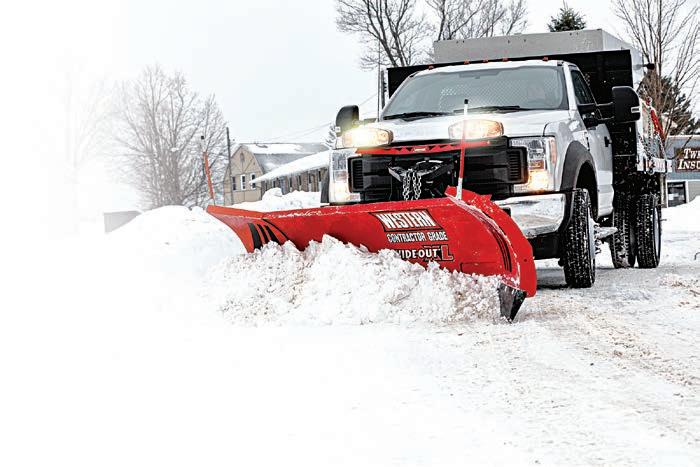
Danziger is celebrating its 70th anniversary by focusing on the future. To mark this milestone, the company is partnering with the Horticulture Research Institute to launch a new scholarship for North American students. The Danziger Imagine More Scholarship Fund is the latest investment in the future of the industry.
“We are very proud of the past 70 years and our growth from a small family farm to one of the leading floriculture companies,” said Ori Danziger, deputy CEO. “We are blessed to be a part of this beautiful industry, to create innovative new varieties and to have the best customers and partners to grow with. Today is about recognizing the blessings of our history. I can’t think of a better way to honour my grandparents — the founders of our company — Ernest and Zehava Danziger — than by supporting the future of our industry. They will both celebrate their 100th birthday soon and we wish them many, many more happy and healthy years.”
Throughout its history, Danziger has always placed a high value on innovation and the power of imagination. “Supporting young students has been a core value for us,” added Ori Danziger. “We have given away more than 200 academic scholarships in Israel. This year we’ve decided to extend our scholarship program to horticulture students in the U.S. We believe that welcoming a new generation with creativity and passion into the business will keep supporting our industry’s growth.
The Danziger Imagine More Scholarship Fund will provide assistance to help horticulture students reach their full potential.


The Concrete Masonry & Hardscapes Association (CMHA) is pleased to announce the winners of the 2022 Safety Awards.

The prestigious honor is bestowed annually upon manufacturing plants and contractors that demonstrate a commitment to the well-being of their employees and their work environment. 158 awards were given out to manufacturing locations and contractors throughout North America
with exemplary records.
“It’s an honor to recognize our members who consistently promote and implement safe working practices,” said CMHA President Bob Thomas. “It is encouraging to see members demonstrate their commitment to safety.”
Participants were eligible for awards through their OSHA 300A logs or equivalent Canadian injury reports from Jan. 1 to Dec. 31, 2022. This year, 10 Milestone Awards were given to facilities with more than five consecutive years of Safety Award Program
entries with zero OSHA/Canadian injury report injuries. For the other categories, CMHA presented: 111 Platinum Awards (highest level of single year achievement), 26 Gold Awards and 11 Silver Awards, based on two formulas — one for Incident Rate (IR), and Days Away for Restrictions and Transfer Rate (DART).
View the list of winners online at masonryandhardscapes.org/2022safety-award-winners

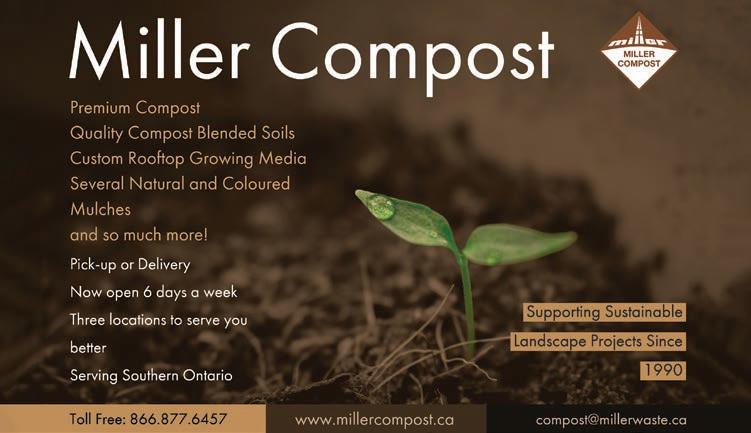
Canadian-owned and operated construction equipment rental company Cooper Equipment Rentals recently announced the acquisition of Warner Rentals Ltd. and Scotty’s Rentals and Landscaping Ltd. in Western Canada. “Our entire team is excited about these two acquisitions. They reaffirm our on-going commitment to building a truly Canadian, coast-to-coast equipment rental company,” said Justin Wharton, Cooper’s western Canada Director of Operations. Coopers currently operates 68 locations in six provinces.
“Adding Warner Rentals and Scotty’s to the Cooper network helps us deliver the Cooper Difference — unsurpassed customer care, the best solutions and deep expertise — at a whole new level in western Canada,” adds Cooper CEO Doug Dougherty.
Warner Rentals was founded in 1975 by owner Ralph Warner and currently has five locations: Kamloops, Princeton, Revelstoke, Salmon Arm and Scotch Creek, B.C. Over the past 48 years, Warner Rentals has become a staple of the communities it serves, with a reputation for quality, integrity, and community involvement.
The acquisition of Warner Rentals sees Cooper expand the company’s footprint in the central British Columbia interior and intensifies their service coverage in a rapidly growing and
important western Canadian market.
Headquartered in Rock View County, Alta., Scotty’s specializes in providing climate control equipment — including heaters, generators, and tarping services — as well as fencing for residential construction. Since their founding in 2007, the company has built a reputation for providing excellent service and support.
The addition of Scotty’s bolsters Cooper’s climate control division, while also adding a new product line in fencing.
“We are excited to join the Cooper family. The company being Canadian was a key factor in this decision, and Cooper’s size allows us to continue to service our customers with a variety of equipment solutions,” said Peter Jensen, owner of Scotty’s.
“These acquisitions not only exemplify our unwavering commitment to expanding our presence in western Canada, but also reinforce our dedication to providing top-tier rental solutions to all major markets across Canada,” said Brian Spilak, Chief Operating Officer of Cooper.
Cooper provides equipment, service and support through products including general tools, earth moving, heavy equipment, aerial, climate control, trench safety and pump and power.

Entries for the 2023 HNA Awards are now being accepted. The annual awards program honors outstanding residential and commercial hardscape projects in nine different categories: concrete paver, combination of hardscape products, clay brick, segmental retaining walls, porcelain pavers, natural stone, outdoor living features and vintage installation. Entries feature hardscaping designs for walkways, patios, pool decks, outdoor living kitchens and living spaces, and driveways as well as commercial plazas and streets.
Award winners will be recognized during the Hardscape North America trade show, Oct. 18-20 in Louisville, Ky. The HNA Awards Ceremony will take place at the Kentucky Exposition Center on Oct. 19. Winners and honorable mention recipients will be featured on the HNA website and in several industry publications.
“The HNA Awards program is not merely a recognition of excellence in hardscape design; it is the transformative catalyst that propels winners to new heights,” said Robert Thomas, president and CEO of the Concrete Masonry & Hardscapes Association. “Annually, the program showcases the ‘best of the best’ in our industry, including creativity, innovation and expertise. I can’t wait to see all the exceptional projects submitted this year!”
All entries, except the vintage installation category, must have been completed between Nov. 1, 2019, and June 30, 2023. vintage installation entries must have been installed before 2013. Projects are juried by industry experts for their excellence in design, craftsmanship, construction, and compatibility. The entry deadline is Sept. 1, 2023.
The HNA Awards are produced by the Concrete Masonry & Hardscapes Association (CMHA) and endorsed by the Brick Industry Association (BIA) and the Natural Stone Institute (NSI). Sponsors for the HNA Awards include iQ Power Tools, Keystone Hardscapes, and Regions Enerbank.
Learn more about the 2022 HNA Awards Winners and Honorable Mention Recipients at hardscapena.com/hnaawards.




The American Rose Society has announced two national honors, which were presented at its recent National Convention in Shreveport, La.
Dr. Mark Windham of Knoxville, Tenn. has been awarded the Joseph and Marion Klima Medal for Excellence in Rose Education. This award is given in fulfillment of the wishes of the late Joseph and Marion Klima of Kentfield, Calif.
Dr. Windham, emeritus professor of plant pathology at the University of Tennessee, is known for his rose education presentations across the nation, speaking at field days, grower meetings, rosarian workshops, master gardener events, extension agent trainings, and consulting Rosarian schools. He spent the last 10 to 15 years giving education presentations to rose societies across the country. He has
been instrumental in helping understand blackspot, cercospora leafspot, downy mildew, and more importantly in the last 10 years, the rose rosette disease. Windham is considered the country’s leading authority on rose rosette disease.

Windham, along with Dr. Alan Windham also from the University of Tennessee and Dr. Alan Henn from Mississippi State University, authored the 2018

e-book, A Guide to Rose Diseases and their Management . Windham continues to take part in research on roses, as he has secured funding with Dr. David Byrne of Texas A&M University and others for USDA Specialty Crop Competitiveness Grants pertaining to rose rosette research. Windham is involved in the research on many of the project objectives but goes the extra mile to then educate rose lovers through educational programs.
Mark Mason Taylor of Sandy, Utah, has been awarded the Rising Star Award. This award was established to honor new stars
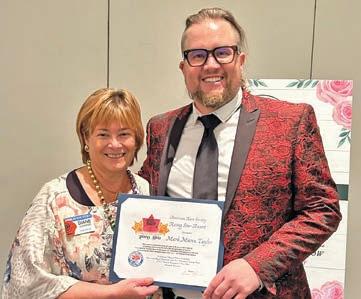


in the rose world in hopes of recognizing and honoring the work of the next generation of rosarians. It is created to recognize those 45 and younger for outstanding achievement by an individual in promoting the culture and appreciation of the rose.
Taylor serves as the strategic development chair for the Utah Rose Society (URS), founded in 1935. Taylor has presented rose-related talks in his community, authored several articles, and helped his local rose society build a new website. He helped build a discount program for URS members which resulted
in a 121 per cent increase in membership. On the state and national level, Taylor has built a relationship with the Utah State University Extension Division to update their public information about landscaping with roses. Taylor is also an evaluator for the American Rose Trials for Sustainability program at the Conservation Garden Park in West Jordan, Utah.
Taylor is also the founder of Perfume Punk, a worker’s co-op which was responsible for saving eight million gallons of water in 2022 through waterwise rose gardens.



With numerous snow clearing attachments and accessories, Toro and Ventrac offer solutions to satisfy all of your snow and ice management needs. The SSV Sidewalk Snow Vehicle’s industry-first compact 36” width makes it your most efficient way to clean sidewalks and other tight areas this winter.




Following years of hard work by a team of volounteers and Landscape Ontario members, an urban greenspace project in Hamilton’s Barton Village celebrated its official grand opening on June 3. The revitalization was completed in partnership with the Green Cities Foundation’s #GreenMyCity project.

Work towards finalizing the new look of St. Matthew’s House, which supports seniors, children and vulnerable members of the community, began in 2019. Dedicated efforts by volounteers over the years have transformed the neglected playground and parking lot corner into an inviting, natural oasis with a vibrant seating area in the courtyard.
“Today is the day where it all comes together,” said St. Matthew’s House Executive Director Renee Wetselaar, seated at a picnic bench in the courtyard following the official grand opening. “It’s really phenomenal what a space like this can do to a neighbourhood.”
Wetselaar said enhancements to the St. Matthew’s House grounds fill a missing need for Barton Village by providing a welcoming outdoor space for neighbours to gather.
“It’ll be here for years and years to come. And I have so much thanks for that.”
The centrepiece of the project was the transformation of the playground area, which highlights natural elements to create an engaging and eco-friendly space. Wooden structures such as climbing features, balance beams and a log bench were carefully installed to encourage active play and stimulate children’s imaginations. These natural play elements offer opportunities for exploration, physical development and social interaction. In addition to the wooden structures is a triangle shade sail, providing a sheltered area for children to enjoy a respite from the sun’s rays. Also adding to the improved aesthetics of the playground is a new fence, providing a visual barrier and a more protected play area for the children.
Near the St. Matthew’s House grounds, volunteers from the Green Cities Foundation built an accessible pathway leading to the community vegetable garden at nearby Birge Park. The pathway, along with the removal of an overgrowth of weeds, rejuvenated the space to be fully accessible. Birch and Woodlands Parks have also been tidied up by volunteers who pruned shrubs and weeded
and mulched garden beds.
“What was done today by dedicated, trained people was beyond anything we could have done as a community with a few volunteers,” said Barton Village resident Brenda Duke. “Their expertise and experience, and willingness to work that hard, just shows their investment in the neighbourhood as well.”

This #GreenMyCity project in Hamilton is a remarkable testament to the strength of community-driven initiatives. The unwavering dedication of our passionate volunteers and the generous support of sponsors and partners has breathed new life into spaces that were previously overlooked and forgotten. Work on St. Matthew’s House and its surrounding parks showcases the immense potential and beautiful results from connecting plants and people to create a greener and healthier urban climate.
“This type of work, it’s not going to solve our climate problems, but our climate problems won’t be solved without projects like this,” said Peter Guinane, who led the St. Matthew’s House revitalization project. “I’m thrilled we got this one done, and we got so many people out and participating today. Now they can take that message and it’ll continue to multiply. Onto the next one.”
Special thanks to the companies that generously donated their time and materials to make this project a reality: Connon Nurseries, Unilock, Turf Systems, Oriole Landscaping, Unique
Landscape Services, Aldershot Landscape Maintenance, Landsource Organix, Garden Grove Landscape, AVK Nursery Holdings, Arborwood Tree Service, Fibertop, Miller Compost, Scotts Canada, Abingdon Heights, BudgetBin, Rockcrest Landscape by Design, Martek Supply, Plant Products and Rain Bird.

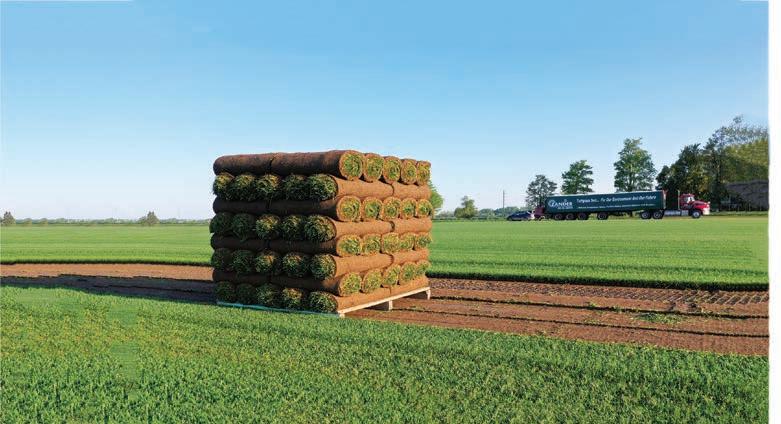
And thank you to our project partners: RBC Insurance, the Federal Economic Development Agency for Southern Ontario, the Hamilton Community Foundation, the City of Hamilton, the Golden Horseshoe Chapter of Landscape Ontario, and the Canadian Nursery Landscape Association membership.





The winners of the 20th annual National Awards of Landscape Excellence (NALE) were announced live on Aug. 9, 2023 during a special reception held at the Fairmont Winnipeg in Manitoba. The event was held in conjunction with the Canadian Nursery Landscape Association’s (CNLA) summer meetings.
The awards recognize Canadian companies that have actively participated in significantly building on the level of professionalism in the landscape industry.
Congratulations to this year’s winners! 2023 National Awards of Excellence winners:
COMMERCIAL LANDSCAPE CONSTRUCTION

Winner: Trim Landscaping

For: Peggy’s Cove
Halifax, Nova Scotia
COMMERCIAL LANDSCAPE MAINTENANCE
Winner: Strathmore Landscape Contractors

For: Consilium Place
LaSalle, Quebec
RESIDENTIAL LANDSCAPE CONSTRUCTION
Winner: Fossil Landscape Construction
For: Modern Luxury Vancouver, British Columbia
AT COIVIC SPECIMEN TREES, WE OFFER A WIDE VARIETY OF THE FINEST QUALITY PLANT MATERIAL. WE INVITE YOU TO VISIT OUR NURSERY AND BROWSE OUR HAND-SELECTED SPECIMEN PIECES.

(905) 878-9101 INFO@COIVIC.COM WWW.COIVIC.COM COIVIC
RESIDENTIAL LANDSCAPE MAINTENANCE




Winner: It’s About Thyme Inc.
For: Urban Oasis
Stratford, Ontario
LANDSCAPE DESIGN
Winner: Planta Landscape Inc.
For: Britannia Residence
Calgary, Alberta
GARDEN CENTRE OF DISTINCTION
Winner: Alternative Garden Centre
Brandon, Manitoba
Sponsored by Greenhouse Canada Magazine
GROWER OF DISTINCTION

Winner: Jefferies Nurseries Ltd.
Portage la Prairie, Manitoba
Sponsored by LMN
GREEN FOR LIFE COMMUNITY AWARD
Green Cities Foundation
For: St. Matthew’s House
Sponsored by Caterpillar



The National Awards of Landscape Excellence are sponsored by: Caterpillar, John Deere, Equinox Environmental Products, Hortprotect, Fenchurch General Insurance Company, and Greenhouse Canada Magazine.
Winners from this year and previous years are highlighted on the CNLA website at cnla.ca/awards. Check out CNLA’s YouTube channel at youtube.com/cnla for videos on all of this year’s finalists and winning projects and past winners.

The rugged MVP 3™ V-plow gives you all the power, productivity and performance you need for commercial snow plowing. All models feature a clean-scraping 70-degree attack angle, and come with a standard 6” highcarbon steel cutting edge to reduce wear and extend the life of the blade. Each blade features independent trip-edge design with heavy-duty coil springs for protection when encountering bumps and obstacles. With extreme flared wings, up to 45”″ on the heavy-duty 10’ 6”″ model, and double-acting cylinders, Western Plow says the MVP 3 V-plow has earned its reputation as a reliable plow.

Western Plow westernplows.com
The all-new TEMPEST™ stainless steel hoppers range in capacities from 0.35 cu. yd. to 5.0 cu. yd., and feature two material delivery system options. Choose from the HELIXX™ shaftless auger system for precise rock salt application or a pintle chain conveyor system for thick, heavy deicing materials. They’re built with corrosion-resistant stainless steel, ensuring longevity and durability. The Trilogy Defense System accessory can also be installed for the ability to spread, pre-wet and spray all with one hopper spreader.
Fisher fisherplows.com

Kubota engines offer the flexibility and performance to fit any application. Their easy maintenance, high power density and low fuel consumption mean more productivity and unbeatable profitability.


The all-new SnowEx® POWER PUSHER™ plows come in 8’ and 10’ widths. A common carrier attachment system with a floating coupler allows compatibility with skid-steers, compact loaders and tractors. The patent-pending TRACE™ (terrain response advanced cutting edge) technology is made up of independent two-foot. sections that oscillate, move vertically and trip. The self-leveling side plates allow the TRACE cutting edge to contour to the plowable surface for maximum snow removal, down to the pavement.


snowexproducts.com
Winter Equipment recently launched a new tool on their website that helps users find the right products and parts for their plows. The Product Finder allows customers to search by brand or plow type to discover more than 80 different commercial plows, including parts, for five of the most popular brands. The locator will include blade systems, plow guards, snow pusher shoes, accessories and hardware.

Winter Equipment
winterequipment.com




Steiner announced their newest attachment, the AirFX™ Mower Deck, an adjustable and easy-to-maintain mower deck available in 61” or 72” width sizes. The mower deck is engineered to handle a variety of turf types and can cut at varied heights between 1-5”. The attachment’s deep-deck bullnose design and patented Air-Gap™ baffle system creates a strong vacuum effect that helps lift the grass, providing a uniform quality of cut.
steinerturf.com





KIOTI Tractor announces the addition of the CK20 and DK20 Series models to its tractor lineup. Many of the new models incorporate new features for enhanced productivity, including LED headlights and updated steel hoods. An integrated joystick enables the operator to perform all loader functions with a single lever, and when combined with the optional third-function valve kit and attachments, unlocks additional capability.
KIOTI Tractor
kioti.com

John Deere’s new P-Tier compact wheel loaders will introduce new productivity-enhancing qualities, including standard ride control in base models and optional factory-installed features, including an autoreversing fan option. Additional optional features include attachment assist controls, which include integrated electrical (three-pin) controls for attachments and combined creep control and throttle lock.
John Deere deere.ca
The Redmax CZTx platform was designed specifically for the commercial landscaper, with a focus on commercial engines, heavy duty pump and wheel motor combinations, cast iron components, heavy gauge steel decks and robust frames. Anti-vibration designs for the entire operator platform and full suspension seats will keep the operator comfortable all day on the roughest terrain. Available with a full line of accessories.
RedMax redmax.com
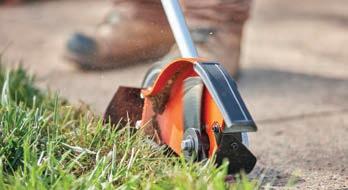

Kress announced its 40V and 60V lines of outdoor power equipment are now available at dealerships across Canada. Inspired by the commercial line, prosumer-grade trimmers, chainsaws, blowers, and mowers have been designed for those looking to achieve high-quality results with clean, quiet products. All Kress 40V and 60V prosumer products are equipped with Kress-built brushless motors and 20V Kross Pack lithium-ion batteries that allow for longer runtimes, fast recharging, and when combined, higher power output.


Kress kress.com
Husqvarna is launching its 525i Battery Series product line that features a powerful new string trimmer and two dedicated edgers, which are equipped with a Husqvarna E-Torq motor to meet the performance of 25cc petrol equivalents while exceeding them in torque. Husqvarna is also releasing an overnight charging rail that can charge up to eight batteries in parallel on one plug.
Husqvarna
husqvarna.com
AUGUST 23-25
FARWEST SHOW
Portland, Oregon farwestshow.com
SEPTEMBER 10-13
ELEVATE BY NALP Dallas, Texas landscapeprofessionals.org/elevate
SEPTEMBER 19
SNOWPOSIUM 2023 Milton, Ontario snowposium.ca
SEPTEMBER 26-29
IPPS EASTERN REGION
ANNUAL CONFERENCE Hamilton, Ontario ippseasternregion.org
SEPTEMBER 28-29
2023 OALA CONFERENCE Toronto, Ont. oala.ca/2023-oala-conference
OCTOBER 17-20
EQUIP EXPO Louisville, Kentucky equipexposition.com
OCTOBER 18-20
HARDSCAPE NORTH AMERICA Louisville, Kentucky hardscapena.com
NOVEMBER 15-16
GREEN INDUSTRY SHOW AND CONFERENCE (GISC) Red Deer, Alberta greenindustryshow.com
JANUARY 9-11, 2024
LANDSCAPE ONTARIO CONGRESS Toronto, Ontario locongress.com
Jody Harbour started deeply exploring her own heritage and roots a little over ten years ago. Since then, she has become a passionate advocate for Indigenous knowledge and culture as co-founder of Grandmother’s Voice, an Indigenous women-led organization, unifying Indigenous voices and welcoming all.

To honour missing and murdered Indigenous women, girls and children, Grandmother’s Voice created a healing garden at their headquarters in Milton, Ont. featuring over 30 native species. We asked Jody to share more about the project and its impact.
As mentioned in the Haudenosaunee Thanksgiving Address, ‘As far as the eye can see, the plants grow working many wonders. They sustain many life forms.’ For me, a medicine or healing garden is a place where I go to rest my mind, body and spirit. I trust the medicines, whether a professionally designed garden by Mother Earth or by a landscaping company, any collection of plants, herbs or food supports and reminds me to be grateful for all the plant life provides.
The knowledge that has been transferred to me by Indigenous Elders is that the respect for the natural world is what will heal the people. Metaphors are a way of interpreting Indigenous beliefs and practices. One metaphor used when referring to Mother Earth, is comparing Mother Earth to
women as the creators of life and nurturers. When the modern world ends the violence, destruction and exploitation of Mother Earth, the harm and violence to our women and girls will end. It is a harsh message to read, however, there is no replacement for our women as they are the creators of life and there is no replacement for Mother Earth as she is what sustains all beings.
Describe the positive effects on well-being and healing experienced by visitors to your garden. This garden was cultivated with the vision of collective hope, love, community, and healing. It has attracted those with the same vision and needs.
This garden came to fruition in time to support the community when the announcement of the 215 graves were found at the Indian Residential School on Tk’emlups te Secwépemc First Nation in Kamloops, B.C., on May 27, 2021.
Describe some ways landscape professionals can create deeper harmony with nature in their designs. I heard Grandmother Renee Thomas-Hill use the term “Groomer of Mother Earth” when referencing a landscaper’s responsibility. I mentioned this to a friend of mine — that when he “groomed mother earth”, to approach her with love and appreciation for her beauty and purpose.”
These thoughts are healing and an approach to positive thinking and wellbeing, all while creating a larger purpose for professionals.
How do you feel about incorporating the four sacred plants (sweetgrass, tobacco, sage, and red cedar) into public gardens? These plants are sacred to Indigenous people, honoured in prayer and ceremony and have significant meaning. Appropriation is what
comes to mind. Without going into a cultural humility training module, I would suggest an Indigenous community member be consulted before any of the ceremonial medicines are planted in a public space. It is imperative the medicines are cared for and not abandoned, as well as having Indigenous people be included in the planning and planting process.
What do you wish more landscapers and non-Indigenous people would implement in their landscapes and gardens? Native species. What I have picked up is that we should be promoting native plants. A crucial element of colonial history is that native plants and trees were burned on Indian reserves to leave the people with no resources. Visitors and settlers came across the waters with invasive species which are now capable of causing extinction of native plants and animals. It would be a great call to action for the people to embrace this as their Truth and Reconciliation work and encourage more native species planting and invasive species removal or relocating.
What are some plant combinations that, when planted together, create a symbiotic relationship and improve biodiversity? The Three Sisters: corn, beans and squash is what I believe is one of the most famous Indigenous plant combinations. These three plants protect and nourish each other in different ways as they grow and provide a solid diet for their cultivators. Another metaphor that immediately came to my mind was the symbolism of the braided sweetgrass, hair of Mother Earth. We are stronger together. LT
If gardens and caring for the earth is something you’re passionate about, be sure to check out the Grounds Management and New Plants issue of Landscape Trades in October.

The KMA 135 R battery-powered KombiEngine is a versatile tool that can efficiently loosen soil, blow debris, trim grass and hedges, prune trees, manicure paths and gardens. The use of one powerhead with 14 separate attachments welcomes more storage space and less maintenance of multiple tools. The KMA 135 R is lightweight, emission-free and quiet in operation. The effortless KMA 135 R features a brushless motor and provides the performance that landscapers and groundskeepers require to complete their work in a timely manner. The ergonomic loop handle provides greater comfort and less user fatigue. Built with three power settings to offer the momentum required for a task, while conserving battery energy and longer battery runtimes.
Battery Power. Made by STIHL.


SPECIFICATIONS
VOLTAGE 36 V
WEIGHT ② 6.8 LB
① Battery and charger sold separately. ② Weight without battery.
STIHL’s Pro-Fleet Commercial Landscape Program is designed to provide commercial landscapers a volume discount on major purchases of five or more landscaping power tools. Visit your STIHL Dealer today to find out more and take advantage of the savings!

